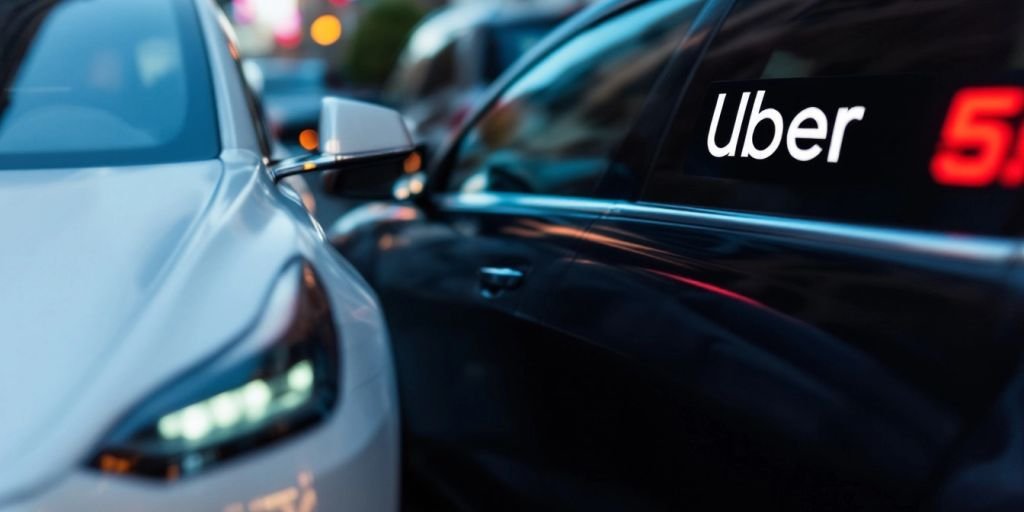In a recent turn of events in the tech and transport sectors, Tesla’s highly awaited robotaxi presentation has left investors feeling let down, while Uber has experienced a boost in its stock value. This article explores the contrasting fortunes of these two companies, highlighting the reasons behind Tesla’s disappointing event and Uber’s successful partnership with Waymo.
Key Takeaways
-
Tesla’s robotaxi event did not meet investor expectations, leading to a significant drop in its stock price.
-
Uber’s partnership with Waymo is expanding, showing promise for future growth in autonomous ride-hailing.
-
Investors are concerned about Tesla’s lack of clear timelines and details regarding its autonomous vehicle plans.
-
In contrast, Uber’s stock rose as it continues to build on its strengths and expand into new markets.
-
Overall market reactions highlight the differing fortunes of both companies in the face of recent developments.
Tesla’s Robotaxi Event: A Disappointment for Investors
Lack of Concrete Timelines
Tesla’s recent robotaxi event left many investors feeling let down. The much-anticipated showcase of the Cybercab did not provide the clear timelines that investors were hoping for. Instead, they were met with vague announcements about production starting in 2026. This uncertainty has caused a significant drop in Tesla’s stock.
Critics’ Reactions to the Cybercab
Critics have voiced their concerns regarding the event. Key points include:
-
Lack of details on the transition from a car manufacturer to a leader in autonomous driving.
-
No information on a promised ride-hailing app.
-
Questions about the practicality of the Cybercab’s features.
Analysts’ Concerns on Tesla’s Future
Analysts are worried about Tesla’s future in the competitive market. They highlight:
-
The absence of a solid business model for the robotaxi.
-
Concerns over safety data that investors are eager to see.
-
The impact of economic indicators on investor sentiment.
The event was seen as crucial for reaffirming Tesla’s market position, but it ultimately raised more questions than it answered. Investors are left speculating about the company’s innovations and competitive edge in the autonomous vehicle market.
Uber and Waymo’s Strategic Partnership

Expansion into New Markets
Uber and Waymo are teaming up to expand their services into new cities. They plan to launch autonomous ride-hailing in Austin and Atlanta by early 2025. This follows their success in Phoenix, where they have already made significant progress.
Strengths of the Collaboration
The partnership combines the strengths of both companies:
-
Uber brings its vast user base and experience in fleet management.
-
Waymo contributes its advanced self-driving technology and expertise in testing.
-
Together, they aim to create a seamless experience for riders.
Industry Observers’ Positive Views
Many industry experts view this partnership positively. They believe it could lead to:
-
Increased competition in the ride-hailing market.
-
Enhanced safety and efficiency in transportation.
-
A stronger foothold in the growing autonomous vehicle sector.
This partnership is a significant step towards making autonomous ride-hailing a reality, showcasing how collaboration can drive innovation in the industry.
Stock Market Reactions: Tesla vs. Uber
Tesla’s Decline in Premarket Trading
Tesla’s stock took a hit after the much-anticipated robotaxi event. As of 6:42 AM EDT on October 11, 2024, the stock was priced at $223.87, reflecting a drop of 6.24% from the previous close of $238.77. This decline has raised concerns among investors, especially given Tesla’s year-to-date return of -3.91%, which is significantly lower than the S&P 500’s gain of 21.18%.
Uber’s Gains Amidst the News
In contrast, Uber’s stock saw a positive shift. It was trading at $81.60, marking an increase of 4.72% from its last close of $77.92. This rise is attributed to the recent expansion of Uber’s partnership with Waymo, which has been well-received by the market. Uber’s year-to-date return stands at an impressive 26.56%, showcasing its strong performance compared to Tesla.
Comparative Analysis of Stock Performance
-
Tesla’s Market Cap: Approximately $762.784 billion
-
Uber’s Market Cap: Around $163.705 billion
-
Tesla’s P/E Ratio: 67.05
-
Uber’s P/E Ratio: 84.70
The contrasting stock performances highlight the differing investor sentiments towards both companies. While Tesla struggles to meet expectations, Uber’s strategic moves are paying off, leading to a more optimistic outlook for its future.
Challenges Facing Tesla’s Autonomous Ambitions

Questions on Practical Implementation
Tesla’s journey towards becoming a leader in autonomous driving is filled with hurdles. Many investors are concerned about how Tesla will turn its ambitious plans into reality. Key issues include:
-
The need for clear timelines on when these technologies will be available.
-
The challenge of ensuring safety and reliability in real-world conditions.
-
The integration of advanced technology into existing infrastructure.
Absence of Promised Ride-Hailing App
Another significant challenge is the lack of a promised ride-hailing app. Investors are eager to see how Tesla plans to compete in this space, especially with established players like Uber and Waymo already making strides. The absence of this app raises questions about Tesla’s overall strategy and market readiness.
Competition in the Autonomous Vehicle Market
The competition in the autonomous vehicle market is fierce. Other companies are rapidly developing their own technologies, which puts pressure on Tesla to deliver results quickly. Key competitors include:
-
Waymo, with its strong focus on safety and technology.
-
Uber, which is expanding its partnerships and services.
-
Traditional automakers investing heavily in autonomous technology.
The road ahead for Tesla is challenging, and the company must address these issues to regain investor confidence and secure its place in the future of transportation.
Uber’s Growth Strategy with Waymo

Fleet Management and Operations
Uber and Waymo are working together to enhance their autonomous ride-hailing services. Here are some key points about their collaboration:
-
Expansion into new cities: They plan to launch services in Austin and Atlanta by early 2025.
-
Fleet size growth: The partnership aims to increase the number of Waymo’s electric vehicles on the road.
-
Shared responsibilities: Uber will handle fleet management while Waymo focuses on its self-driving technology.
Technological Advancements
The partnership is also about improving technology:
-
Advanced self-driving systems: Waymo’s technology is among the best in the industry.
-
Integration with Uber’s platform: This will allow for smoother user experiences.
-
Continuous testing: Both companies are committed to refining their systems for safety and efficiency.
Future Plans for Expansion
Looking ahead, Uber and Waymo have exciting plans:
-
Broader market reach: They aim to enter more cities in the future.
-
Innovative features: New technologies will be introduced to enhance user experience.
-
Sustainability goals: The focus will be on using electric vehicles to reduce carbon footprints.
This partnership is seen as a significant step forward in the race for autonomous ride-hailing services, combining Uber’s vast user base with Waymo’s cutting-edge technology.
Investor Sentiment and Market Impact
Market Expectations from Tesla
Investor expectations for Tesla have been significantly impacted by the recent robotaxi event. The event showcased Tesla’s ‘cybercab’ but failed to provide clear timelines, leading to disappointment among investors. Key points include:
-
A 6% drop in Tesla’s stock following the event.
-
Analysts expressing concerns about Tesla’s future in the autonomous vehicle market.
-
A lack of concrete details regarding the rollout of the robotaxi service.
Uber’s Positive Market Reception
In contrast, Uber has seen a positive shift in investor sentiment. Following the announcement of its expanded partnership with Waymo, Uber’s stock rose nearly 5%. This shift indicates:
-
Increased confidence in Uber’s strategy for autonomous ride-hailing.
-
A strong collaboration that leverages both companies’ strengths.
-
Positive feedback from industry observers regarding the partnership’s potential.
Long-term Implications for Both Companies
The contrasting fortunes of Tesla and Uber highlight the evolving landscape of the autonomous vehicle market. Investors are now more cautious about Tesla’s ambitions while showing optimism towards Uber’s growth strategy.
The recent events underscore the importance of clear communication and strategic partnerships in shaping investor sentiment in the tech-driven transport sector.
Technological Innovations in Autonomous Driving
Tesla’s Cybercab Features
Tesla’s latest vehicle, the Cybercab, showcases several innovative features that aim to redefine the driving experience. Key highlights include:
-
No steering wheel or pedals, allowing for a fully autonomous ride.
-
Advanced sensors and cameras that enhance safety and navigation.
-
A projected operating cost of just 20 cents per mile, making it economical for users.
Waymo’s Autonomous Technology
Waymo continues to lead in the field of self-driving technology. Their approach includes:
-
A fleet of fully autonomous, all-electric vehicles, ensuring a sustainable future.
-
Continuous testing in various environments to improve reliability.
-
Partnerships with companies like Uber to expand their reach and effectiveness.
Future Trends in the Industry
The future of autonomous driving looks promising, with several trends emerging:
-
Increased integration of AI for better decision-making.
-
Expansion of autonomous services into new markets.
-
A projected 90% of vehicles in Europe and America offering level 1 autonomous features by 2024.
The advancements in autonomous driving technology are not just about convenience; they are set to transform the entire transportation landscape, making it safer and more efficient for everyone.
In the world of self-driving cars, exciting new technologies are changing how we travel. These innovations promise safer and smarter journeys for everyone. If you want to learn more about these advancements and how they can impact your life, visit our website for more insights!
Final Thoughts
In summary, the recent robotaxi event by Tesla did not live up to what many investors had hoped for, leading to a drop in its stock price. On the other hand, Uber has seen a rise in its stock value, thanks to its growing partnership with Waymo. This contrast highlights the different paths these companies are taking in the self-driving car market. While Tesla’s ambitious plans are still in the future, Uber’s immediate gains show that investors are more confident in its current strategies. As the market evolves, it will be interesting to see how these two giants adapt and compete.
Frequently Asked Questions
What happened during Tesla’s robotaxi event?
Tesla held a big event to show off its new robotaxi, called the Cybercab, but many investors were not happy with what they saw.
Why did Tesla’s stock drop after the event?
Investors were expecting more details and clearer timelines, but they felt disappointed with the information provided.
What are Uber and Waymo’s plans for their partnership?
Uber and Waymo are teaming up to bring self-driving ride services to cities like Austin and Atlanta by early 2025.
How did the stock prices of Tesla and Uber react after the news?
After the news, Tesla’s stock fell by over 6% while Uber’s stock rose by nearly 5%.
What challenges is Tesla facing with its self-driving cars?
Tesla needs to show how it will make its self-driving technology work in real life and also needs to compete with other companies.
What is Uber’s strategy for growth with Waymo?
Uber plans to manage a fleet of Waymo’s self-driving cars, which will help them expand their services and improve technology.





